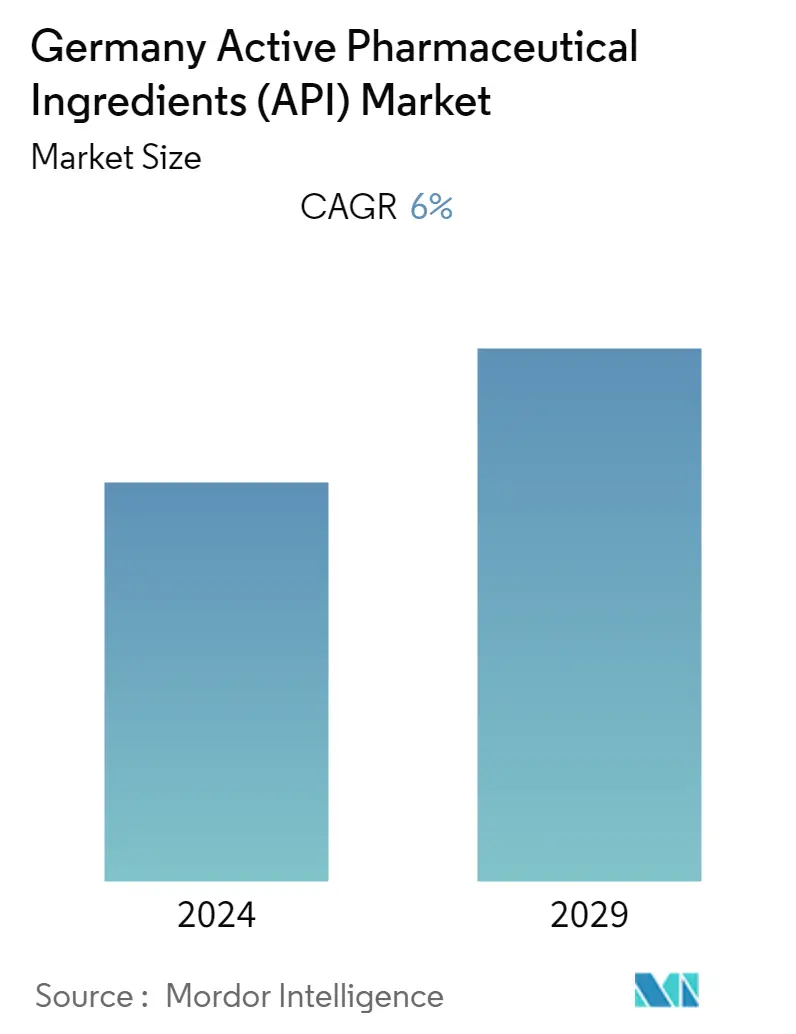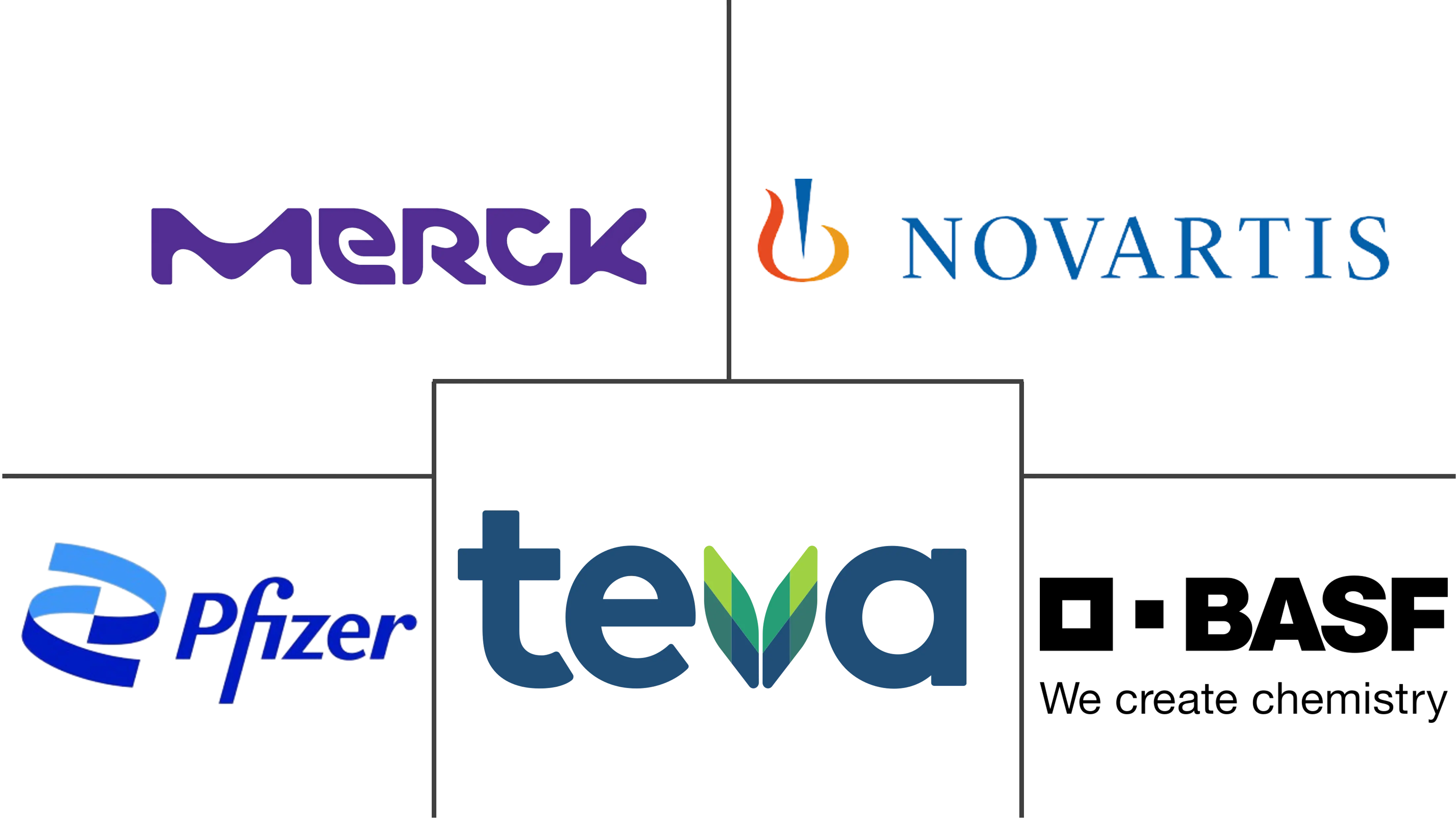Market Size of Germany Active Pharmaceutical Ingredients (API) Industry

| Study Period | 2019 - 2029 |
| Base Year For Estimation | 2023 |
| Forecast Data Period | 2024 - 2029 |
| Historical Data Period | 2019 - 2022 |
| CAGR | 6.00 % |
Major Players
*Disclaimer: Major Players sorted in no particular order |
Germany Active Pharmaceutical Ingredients (API) Market Analysis
The German Active Pharmaceutical Ingredients (API) market is expected to register a CAGR of 6% over the forecast period.
The COVID-19 pandemic negatively impacted the entire pharmaceutical supply chain, along with disrupting the supply of APIs from India and China. As per the Germany Trade and Commerce, in July 2021, Germany's Federal Minister of Health initiated consultations with European Union partners about the possibility of moving the production of certain active pharmaceutical ingredients (APIs) back to Germany. There was a sharp increase in the shortage risk for essential drugs, such as antibiotics and narcotics for surgery. Due to the shortages, the cost of various medicines and active substances like paracetamol increased, turning the manufacture of medications into a loss-making business. Due to unexpected and massively growing demand in the market, along with expanded delivery delays among the active ingredient manufacturers, various pharmaceutical companies, such as Ratiopharm, canceled orders of certain drugs for winter stockpiling. Such issues forced the government to import medicines based on Tamoxifen from other countries to reduce the shortages. However, with released restrictions and resumed import-export activities across the globe, the studied market is expected to grow over the forecast period.
Other factors, such as the rising prevalence of infectious, genetic, cardiovascular, and other chronic disorders, the rising prevalence of cancer with growing sophistication in oncology drugs research, and the growing adoption of biologics and biosimilars, are boosting the market growth.
The increasing burden of chronic diseases, such as diabetes, neurological disorders, and stroke, are the key factors driving the market growth. As stated by the Alzheimer's Association's 2022 report, more than 1.5 million people in Germany are suffering from Alzheimer's. This number is expected to double by 2050. Thus, the high number of people suffering from Alzheimer's will increase the demand for medicine, which is anticipated to augment the market growth over the forecast period.
Additionally, the rising incidences of infectious diseases in Germany is increasing the demand for APIs for drug and vaccine development. A study published in Clinical Infectious Diseases in October 2022 observed that Invasive Pneumococcal Disease (IPD) levels in children aged 0 to 4 years old began to rebound to baseline levels in April 2021. In addition, IPD cases in people 80 years and older, adults 15 to 34, and children 5 to 14 went above baseline levels in July 2021. Thus, the increasing burden of infectious diseases among the population in the country raises the demand for effective drugs, which further increases the demand for APIs for drug development. This is anticipated to fuel the market growth over the forecast period.
Furthermore, the increasing health expenditure in the country reflects the government and companies' focus on developing effective and safe drugs for treating various chronic as well as other diseases. For instance, according to the data published by OECD in June 2022, Germany's health spending rose sharply from 12.5% in 2020 to 12.8% in 2021 as a share of its GDP. This increase in expenditures is expected to boost the development of treatment drugs and APIs, positively impacting the market growth.
Moreover, the growing company initiatives in developing drugs and increasing adoption of various business strategies, such as collaboration and acquisitions, are also contributing to the market growth. For instance, in June 2022, Sandoz expanded its portfolio with the launch of the generic drug Dimethyl fumarate HEXAL, for the treatment of adults with relapsing-remitting multiple sclerosis (RRMS), in Germany. In November 2022, the Annual Highly Potent Active Pharmaceutical Ingredients Forum took place in Berlin, Germany on the 23rd and 24th of November. The forum addressed the biggest challenges the industry is facing in current conditions in occupational toxicology, like the regulatory landscape, determining toxicology limits, and assessing hazards.
Therefore, owing to the aforementioned factors, the studied market is expected to grow over the forecast period. However, the drug price control policies in the country, stringent regulations for drug approvals, and high competition between API manufacturers are expected to impede the growth of the active pharmaceutical ingredients market over the forecast period.
Germany Active Pharmaceutical Ingredients (API) Industry Segmentation
An Active Pharmaceutical Ingredient (API) is a part of any drug that produces its effects. Some drugs, such as combination therapies, have multiple active ingredients to treat different symptoms or act in different ways. They are produced using highly technological industrial processes during the research and development and the commercial production phase.
The Germany Active Pharmaceutical Ingredients (API) Market is Segmented by Business Mode (Captive API and Merchant API), Synthesis Type (Synthetic and Biotech), Drug Type (Generic and Branded), and Application (Cardiology, Oncology, Pulmonology, Neurology, Orthopedic, Ophthalmology, and Other Applications). The report offers the value (in USD billion) for the above segments.
| By Business Mode | |
| Captive API | |
| Merchant API |
| By Synthesis Type | |
| Synthetic | |
| Biotech |
| By Drug Type | |
| Generic | |
| Branded |
| By Application | |
| Cardiology | |
| Oncology | |
| Pulmonology | |
| Neurology | |
| Orthopedic | |
| Ophthalmology | |
| Other Applications |
Germany Active Pharmaceutical Ingredients (API) Market Size Summary
The German Active Pharmaceutical Ingredients (API) market is poised for growth, driven by several key factors. The market is recovering from the disruptions caused by the COVID-19 pandemic, which had a significant impact on the pharmaceutical supply chain and API production, particularly from India and China. The German government, in collaboration with European Union partners, is taking steps to bolster domestic API production to mitigate shortages of essential drugs. The increasing prevalence of chronic diseases, such as diabetes, neurological disorders, and cancer, is fueling demand for APIs, as is the rising incidence of infectious diseases. This demand is further supported by the growing adoption of biologics and biosimilars, as well as increased health expenditure aimed at developing effective treatments. The oncology segment, in particular, is expected to witness significant growth due to the rising burden of cancer cases and the need for advanced oncology drugs.
The market landscape is characterized by a high level of activity among key players, who are engaging in collaborations, facility expansions, and strategic partnerships to maintain their competitive edge. Companies like Aurobindo Pharma, Teva Pharmaceutical Industries Ltd, Pfizer Inc., Novartis AG, BASF SE, and Merck KGaA are actively involved in these initiatives. The branded segment is also anticipated to grow, driven by the high burden of chronic diseases and the increasing awareness and demand for branded drugs. The development of new facilities, such as Evonik's cGMP facility in Hanau, Germany, further supports the market's expansion by enhancing the production capabilities for advanced drug delivery systems. Despite challenges such as drug price control policies and stringent regulations, the German API market is expected to experience robust growth over the forecast period.
Germany Active Pharmaceutical Ingredients (API) Market Size - Table of Contents
-
1. MARKET DYNAMICS
-
1.1 Market Overview
-
1.2 Market Drivers
-
1.2.1 Increasing Prevalence of Infectious, Genetic, Cardiovascular, and Other Chronic Disorders
-
1.2.2 Increasing Adoption of Biologicals and Biosimilars
-
1.2.3 Rising Prevalence of Cancer and Increasing Sophistication in Oncology Drugs Research
-
-
1.3 Market Restraints
-
1.3.1 Stringent Regulations and Drug Price Control Policies
-
-
1.4 Industry Attractiveness - Porter's Five Forces Analysis
-
1.4.1 Threat of New Entrants
-
1.4.2 Bargaining Power of Buyers
-
1.4.3 Bargaining Power of Suppliers
-
1.4.4 Threat of Substitute Products
-
1.4.5 Intensity of Competitive Rivalry
-
-
-
2. MARKET SEGMENTATION (Market Size by Value - USD million)
-
2.1 By Business Mode
-
2.1.1 Captive API
-
2.1.2 Merchant API
-
-
2.2 By Synthesis Type
-
2.2.1 Synthetic
-
2.2.2 Biotech
-
-
2.3 By Drug Type
-
2.3.1 Generic
-
2.3.2 Branded
-
-
2.4 By Application
-
2.4.1 Cardiology
-
2.4.2 Oncology
-
2.4.3 Pulmonology
-
2.4.4 Neurology
-
2.4.5 Orthopedic
-
2.4.6 Ophthalmology
-
2.4.7 Other Applications
-
-
Germany Active Pharmaceutical Ingredients (API) Market Size FAQs
What is the current Germany Active Pharmaceutical Ingredients (API) Market size?
The Germany Active Pharmaceutical Ingredients (API) Market is projected to register a CAGR of 6% during the forecast period (2024-2029)
Who are the key players in Germany Active Pharmaceutical Ingredients (API) Market?
Teva Pharmaceutical Industries Ltd, Pfizer Inc., Novartis AG, BASF SE and Merck KGaA are the major companies operating in the Germany Active Pharmaceutical Ingredients (API) Market.

